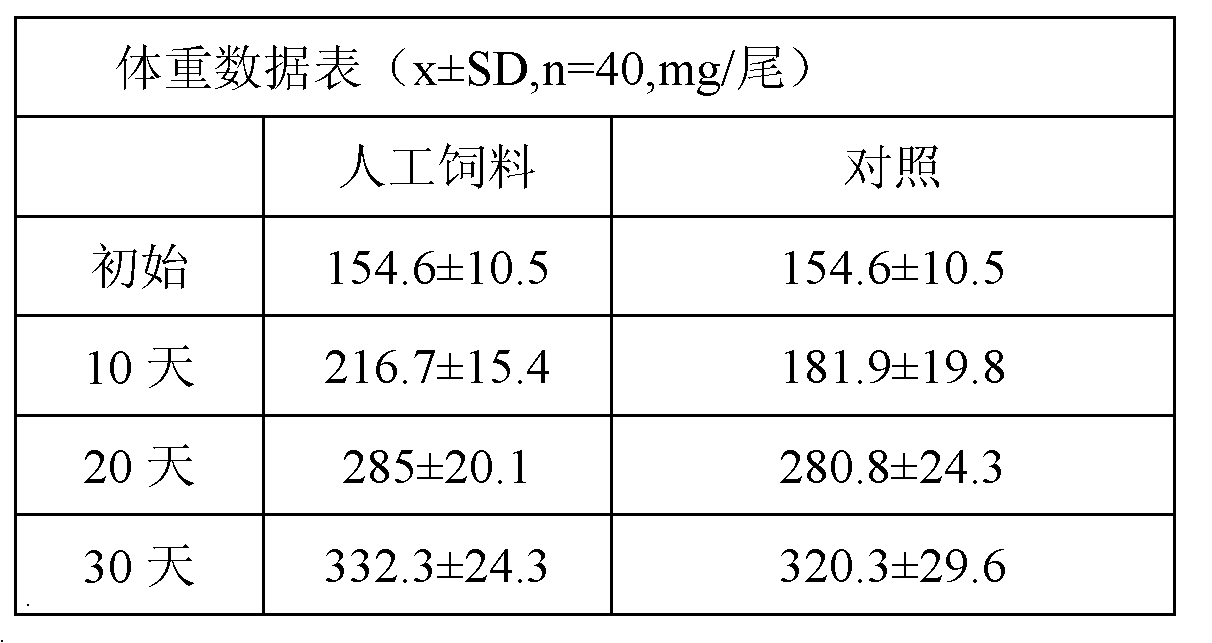Artificial hatch feed for brachymystax lenok fry
A technology of opening feed and leptospirosis, which is applied in animal feed, animal feed, application, etc., can solve the problems of difficult large-scale breeding of larvae, high feed cost, and high labor intensity of workers, and achieves easy promotion, low cost, The effect of easy operation
- Summary
- Abstract
- Description
- Claims
- Application Information
AI Technical Summary
Problems solved by technology
Method used
Image
Examples
specific Embodiment approach 1
[0009] Specific embodiment one: present embodiment leptospirosis larvae artificial opening feed is by mass parts by the Peruvian fishmeal of 20~35 parts, the Norwegian fishmeal of 10~25 parts, the fish oil of 3~5 parts, the soybean oil of 5~7 parts, 3-5 parts of soybean lecithin, 5-8 parts of whole egg powder, 5-8 parts of milk powder, 3-6 parts of frozen water earthworm powder, 3-6 parts of algae powder, 0.5-1 part of betaine, 2-4 parts of cooked starch, 7-9 parts of multivitamins, 3-5 parts of mixed mineral salts, 1-3 parts of carboxymethyl cellulose and 0.01-0.5 parts of vitamin E.
[0010] The preparation method of the artificial opening feed for larvae larvae in this embodiment is as follows: after the Peruvian fish meal and Norwegian fish meal are filtered through a 60-mesh sieve, weigh the various components of the artificial opening feed for larvae larvae according to the number of parts, and stir evenly , gradually add water and stir until dough is formed, knead on a ...
specific Embodiment approach 2
[0012] Specific embodiment two: the difference between this embodiment and specific embodiment one is that the artificial opening feed for larvae larvae consists of 25 to 30 parts of Peruvian fish meal, 12 to 22 parts of Norwegian fish meal, and 3.5 to 4.5 parts of fish meal by mass. Fish oil, 5.5-6.5 parts of soybean oil, 3.5-4.5 parts of soybean lecithin, 5.5-7.5 parts of whole egg powder, 5.5-7.5 parts of milk powder, 3.5-5.5 parts of frozen water worm powder, 3.5-5.5 parts of algae powder , 0.6-0.8 parts of betaine, 2.5-3.5 parts of cooked starch, 7.5-8.5 parts of multivitamins, 3.5-4.5 parts of mixed mineral salts, 1.5-2.5 parts of carboxymethyl cellulose and 0.05-0.4 parts composition of vitamin E. Others are the same as in the first embodiment.
specific Embodiment approach 3
[0013] Specific embodiment three: what this embodiment is different from specific embodiment one is that the artificial opening feed of leptospirosis is made of 30 parts of Peruvian fish meal, 15 parts of Norwegian fish meal, 4 parts of fish oil, and 6 parts of soybean oil by mass. , 4 parts of soybean lecithin, 6 parts of whole egg powder, 7 parts of milk powder, 5 parts of frozen water earthworm powder, 5 parts of algae powder, 1 part of betaine, 3 parts of cooked starch, 8 parts of various Vitamins, 4 parts of mixed mineral salts, 1.95 parts of carboxymethylcellulose and 0.05 parts of vitamin E. Others are the same as in the first embodiment.
PUM
 Login to View More
Login to View More Abstract
Description
Claims
Application Information
 Login to View More
Login to View More - R&D
- Intellectual Property
- Life Sciences
- Materials
- Tech Scout
- Unparalleled Data Quality
- Higher Quality Content
- 60% Fewer Hallucinations
Browse by: Latest US Patents, China's latest patents, Technical Efficacy Thesaurus, Application Domain, Technology Topic, Popular Technical Reports.
© 2025 PatSnap. All rights reserved.Legal|Privacy policy|Modern Slavery Act Transparency Statement|Sitemap|About US| Contact US: help@patsnap.com

